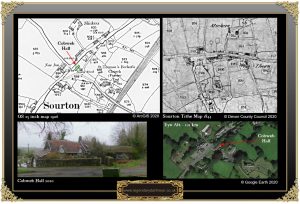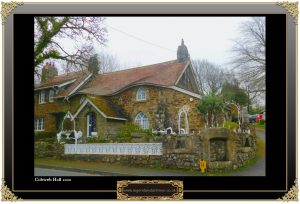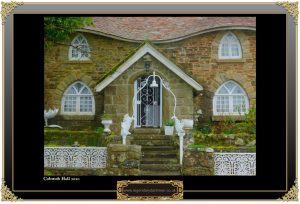
As you drive along the A386 and pass through the small village of Sourton the chances are that your eyes will be immediately drawn to the ornate pub, ‘The Highwayman’ sitting on the righthand side. Originally this was once an old hostelry called the ‘New Inn’ which in the 1970s was then transformed into the spectacle there today. However, should your attention be drawn to the building on the opposite side of the road you would see what today is known as ‘Cobweb Hall’, another surreal structure which in itself has quite a history.
In the June of 1892 the then vicar of Sourton, William Marle placed a notice in the Exeter and Plymouth Gazette appealing for funds. The reason being that; “There is neither schoolhouse, parish room, house of residence, nor yet any resident of means able to give substantial help; and nothing at all adequate to the requirements of parochial can be accomplish while the minister is obliged to live five miles away from the church…” The notice then listed various people that had already donated to his cause to the grand sum of £49 which clearly was a drop in the ocean for what was needed.
In 1897 it was decided that still Sourton desperately needed a church hall and so plans were once again set in motion. At first the parish squire, Mr. V. W. Calmady Hamlyn approached the Parish Council to inquire as to the possibility of funding. In his request he had also offered to donate the land on which the hall could be built along with £50 towards its cost. Oddly enough they refused his kind gesture so in the March of that year he wrote to the vicar, Rev. Puckridge, of Sourton. In the letter he stated that as the money was not forthcoming from the council he would donate the land on which to build the hall along with £50 towards the building costs. As the Parish Council declined his offer he gifted the land and money to the vicar of Sourton. His only conditions were that the Parish Council were to be given use of the building for meetings (I think I would have told the council to whistle) and that any non-conformist bodies were allowed to hold social meetings there. He also requested he and other parties were allowed use of the building for political meetings. Work then started on the building under the auspices of Mr. C. J. Tait the architect and Mr. Warden of Bridestowe as the contractor. The hall was built with local stone along with granite coigns and a tiled roof. It consisted of one large room 32 ft. by 16 ft. which was capable of being divided into two rooms along with a kitchen and able to accommodate 80 people for meetings etc.
On the 22nd of June 1897 as part of the Queen’s Jubilee celebrations the foundations for the church hall were laid and work began in earnest. On Tuesday the 28th of September 1897 at six o’clock a procession went from the church to the partly built hall to lay memorial stones to Mr. Calmady Hamlyn for his kindness in donating the land and monies. Sadly he was due to attend the ceremony but had passed away prior to the vent hence the memorial stone (oddly enough as I write this in the middle of the 2020 Corvid 19 outbreak, the poor squire actually died from the effects of influenza.) In his place the heir to his estates, Mrs Sillifant laid the stone which was inscribed, “In Memorium V. W. C. Hamlyn.” As well as being the local squire he had been a barrister, Justice of the Peace and a captain in the Royal North Devon Hussars. There are various reports of how he met his death, one stated he died of influenza which as I write this during the Covid 19 outbreak of 2020 is topical. Another report stated that after running across a field in order to investigate the sound of gun shots he collapsed and was later found dead, it was noted that previous to this he had been complaining of pains near his heart.In addition the Bishop of Crediton laid another memorial stone inscribed “V R. 1937 – 1897,” to commemorate the Queen’s jubilee in the plinth of the porch.
This still left an outstanding £30 to be raised by the parish to allow the hall’s completion. In order to boost the building funds a sale of artwork was held which raised £4 10s and a tea was laid on which raised £7 6s 4d all of which went towards the church hall fund. This was to be quite a task as the Sourton area was not as prosperous as it once was due to the decline in the local mining industry. The first public event was held in the new Jubilee Church Hall in the first week of June 1888 when the Sourton Friendly Society held their annual day. In later years the hall also served as the local school room.
The history of Cobweb Hall then jumps forward to 1975 when the then owner of what was by then ‘The Highwayman‘ bought the property. Having almost completed the transformation of the inn into the fantasy structure the owner decided to follow suit on the old church hall. Initially there was a dispute between the owner and the local planning authority who insisted that the structure be demolished to within two feet of the foundations because of the unusual roof line and shape of the windows. Eventually the matter reached a minister from the Department of the Environment who came out to inspect the property. In a complete ‘U’ turn he decided that; “a little eccentricity is not a bad things’ and allowed the transformation to take place. – Knowling, p.15.
Sir Nikolaus Pevsner, the famous writer on art and architecture and co-author of ‘The Buildings of England – Devon’ visited Sourton where he commented on several places of note – the church, nearby Bearslake, Sourton Ice Factory and the ‘former village hall’. Oddly enough he gave no mention to ‘The Highwayman’. Of the hall he noted; “converted to a Disneyland cottage orné, in 1978. Rubble walls, coy undulating eaves. Gothic Windows.” – Pevsner, p.745. English Heritage define the term cottage orné as being “A rustic building of picturesque style,” but the actual term has its roots in the ‘Romantic Movement’ of the late 17th and early 18th centuries. This basically was led by famous artists, writers and poets of their time who went in search of ‘rustic nostalgia’ which then found its way into their paintings, poems and writings. Probably on of the leaders of this movement in the UK was William Gilpin who toured the country in search of the ‘picturesque’ and extolling its virtues. I would image Pevsner’s ‘Disneyland’ description alludes to the ‘fantasy’ appearance of the building. Today Cobweb Hall is used for holiday accommodation attached to the Highwayman Inn.

Knowling, P. 2002. Dartmoor Follies. Newton Abbot: Orchard Publications.
Pevsner, N & Cheery, B. 1991. The Buildings of Devon. London: Vale University Press.
 Legendary Dartmoor The many aspects past and present of Dartmoor
Legendary Dartmoor The many aspects past and present of Dartmoor




